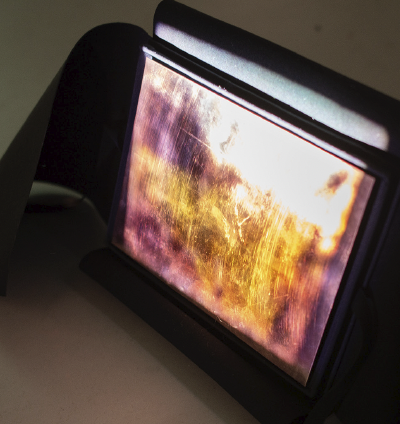Abstract
Proto-photographic and proto-cinematic technologies are an unending source of inspiration for a visual artist. We want to consider the case of an eighteenth-century optical device, the Claude mirror, as a starting point for an artistic collaboration.
The Claude mirror is a small black convex mirror named after the painter Claude Lorrain and used by late eighteenth-century and early nineteenth-century painters and travellers for viewing landscapes. The dark mirror surface produces an image with a limited tonal range, allowing the viewer to look at the environment as if it were a painting. A famous Thomas Gainsborough drawing shows a man seated on a bank with a sketchbook on his lap and holding an oval mirror propped against a tree branch (Gainsborough, 1750-55).
In spring 2019, in a flash of joint inspiration, we conceived a method of combining aspects of our artistic processes: Salla’s moving image and Laura’s printmaking practice. For 18 months, we captured photographic time-lapse sequences of everyday views from the backyards of our studios, residencies, and homes as reflections on the surface of copper plates installed in the environment (Myllylä and Vainikka, 2021). In the resulting installation, titled Claude Chamber, we projected the video sequences on the gallery space, reflected via the same mirror surfaces, and the projected images became distorted and spatial.
We were intrigued by this optical device, in which characteristics of photography and printmaking meet. One can think of a Claude glass as a predecessor of the camera viewfinder, an early photographic gesture. It can also be viewed as a printing plate, a matrix reflecting a view. In a traditional printing plate, the image is attached or fastens itself onto the surface of the plate; in our installation, the image is transient and moving.
References
Batchen, G. (1997) Burning with desire: The conception of photography. Cambridge: MIT Press.
Crary, J. (1990) Techniques of the observer: On vision and modernity in the nineteenth century. Cambridge, Mass.: MIT Press.
Gainsborough, T. (1750-55) Study of a Man Sketching Using a Claude Glass [online]. Available at: https://www.britishmuseum.org/collection/object/P_Oo-2-27
Herrera, I. (2021) A Story of Dust and Mud, [online]. Available at: http://www.inma-herrera.com/A- Story-of-Dust-and-Mud-2021 (Accessed: 13 June 2022)
Kallio P. (2017a) ‘New strategies—Printmaking as a spatial process, as a transmissional process, and as a spatial-transmissional process’ in Pettersson, J. (ed). Printmaking in the expanded field: A pocketbook for the future, collected texts and thoughts. Oslo, Norway: Oslo National Academy of the Arts, pp. 87- 105.
Kallio, P. (2017b) ‘Välissä ja vyöhykkeellä’ in Kallio P. (ed.) Siirtämisen ja välittymisen taide. Helsinki: Taideyliopiston Kuvataideakatemia, pp. 16-63.
Lord, B. (2011) ’Gary Beydler (1944-2010)’, X-TRA, 13(3) [online]. Available at: https://www.x-traonline.org/article/gary-beydler-1944-2010 (Accessed: 26 May 2022)
Maillet, A., Fort, J. (2004) The Claude Glass: Use and Meaning of the Black Mirror in Western Art. New York (N.Y.): Zone Books.
Metzger, C. (2019) ‘The Iron Age: The Beginnings of Etching about 1500‘ in Jenkins C., Orenstein N. and Spira F. The Renaissance of Etching. New York: The Metropolitan Museum of Art, pp. 25-63.
Myllylä, S., Vainikka, L. (2021), Salla Myllylä and Laura Vainikka: Claude Chamber (2021), trailer [video]. Available at https://vimeo.com/490687923 (Accessed: 13 June 2022)
Stijnman, A. (2012) Engraving and Etching 1400-2000: A History of the Development of Manual Intaglio Printmaking Processes. London: Archetype Publications.
Orenstein, N., Stijnman, A. (2019) ‘Bitten with Spirit: Etching Materials and Techniques in the Sixteenth Century’ in Jenkins C., Orenstein N. & Spira F. The Renaissance of Etching. New York: The Metropolitan Museum of Art, pp. 15-23.
Vertanen, A. (2021) ’Huokoinen matriisi’, in Heikkilä, M., Vertanen, A. (eds.) Printed matters: Merkitysten kerroksia. [Helsinki]: Taideyliopiston Kuvataideakatemia, pp. 57-77."

This work is licensed under a Creative Commons Attribution 4.0 International License.
Copyright (c) 2024 Salla Myllylä, Laura Vainikka
